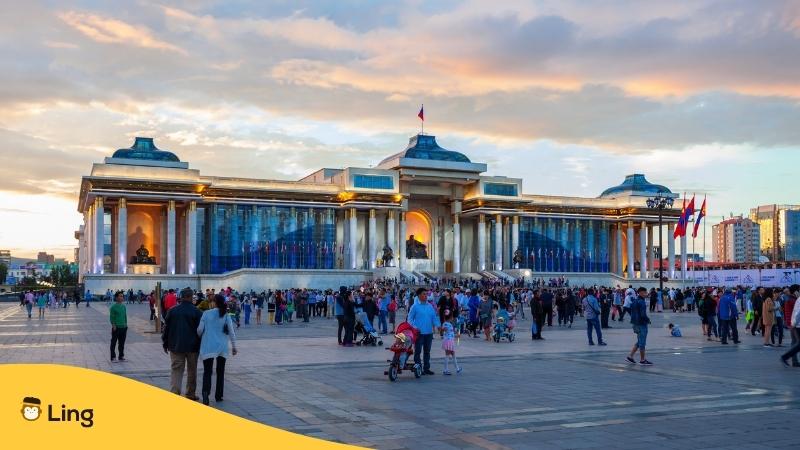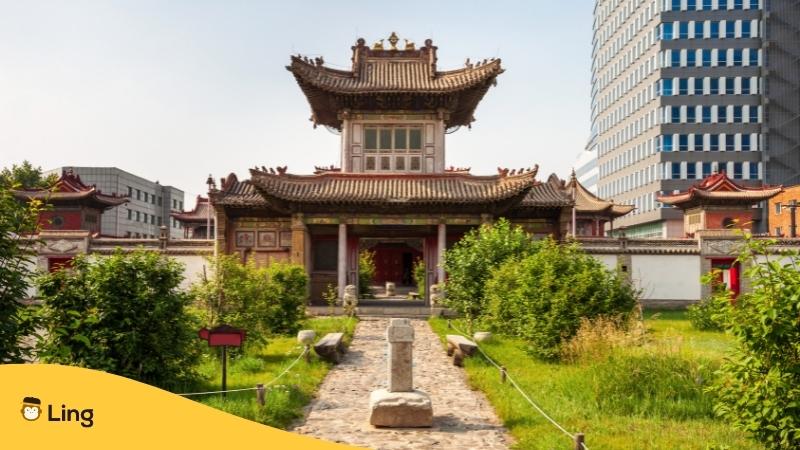Planning to visit the capital of Mongolia, which also happens to be the world’s coldest capital? Yes, you read that right! Ulaanbaatar city is a freezing place to be, so if you are thinking of traveling there late in the year, don’t forget to pack extra cardigans and heat-tech lined coats. As we always say, it’s never enough that you know the Mongolian language when traveling, as you also need to learn a thing or two about the country to appreciate it better. Get to know more about this fantastic place in today’s post!
Mongolia is a beautiful country that spans 603 909 square miles, which makes it the third largest sparsely populated country in the world. It is located in Central Asia, and its land is made up of mountains, dessert, and luscious greens. With 3.3 million citizens, Mongolia is still known for preserving nomadic practices. What gets more interesting are the people, cultural heritage, and landscapes. Let’s take a look at what the city has to offer in the sections below!
Ulaanbaatar: Capital City Of Mongolia

Ulaanbaatar, also called Ulan-Bator, serves as the capital city of Mongolia and is home to over a 1.6million people, making up almost half of the total population of Mongolia. This beautiful city is also the largest in Mongolia and serves as the administrative and business hub of the country.
History
Ulaanbaatar city, formerly called Urgar, was founded in 1639 to serve as a nomadic Buddhist monastery. During its early year serving as the seat of Jebtsundamba Khutuktu, the spiritual leaders of Tibetan Buddhism in Mongolia, Urgar became a religious center and attracted more people, leading it to become a potential settlement for people. In 1727, a caravan route was opened along the city between Beijing and Kyahta, leading to the Genesis of Urgar becoming a full-blown town.
However, things took a turn as the Qing Empire collapsed in 1911, and the town went through a series of political decisions and deliberation to become the capital city of Mongolia. Finally, Ulaanbaatar became the capital of the Mongolia people’s republic in 1924 and experienced a modern renovation in the 1950s. The Ger district was replaced with modern flats, and since then, the place has experienced more and more development.
Geography And Climate

Ulaanbaatar is located 4,430ft above sea level and occupies 4,704 kilometers of land, making it bigger than most cities worldwide. The territory houses Bogd Khan Uul, a thick mountainous-forest area in its south. The Tuul River flows through the southern part of Ulaanbaatar into the Selenge river. The Bogd Khan Uul forest houses many useful trees like deciduous poplars, pines, willows, and much more.
Due to its elevated state above sea level and other effects, Ulaanbaatar is extremely cold during the winter season, and the temperature can drop as low as -40C, making the winter season unbearable if you are not well prepared. You will experience brief, warm summers followed by long and terrible winter seasons. However, the inhabitants of Ulaanbaatar have gotten used to this and have devised ways to keep themselves warm in the awful cold.
Architecture And Tourist Attractions
Ulaanbaatar is a mixture of modern and ancient. You will see soviet-styled flats, small shops, and big buildings all around Ulaanbaatar. It gives you a feeling of the 1950s with the styled flats and the present technological advancement with the tall, gigantic buildings.
National Museum

This is one place you can learn more about Mongolia’s history. It richly displays the evolution of the Mongolian people right from the stone age and takes you through the unique culture and religion of the Mongolians. Another museum worth visiting in Mongolia is the Natural History Museum.
Choijin Lama Monastery
Mongolians are historically Buddhist, and you get to experience what one of the monasteries looks like. Note that this monastery is no longer operational and is only open for tourist purposes. Chioijim lama was a title given to Luvsan Haidav as the state Oracle of Mongolia.
The monastery holds five temples, and the main temple has the sculpture of Chiooijim lama and the mummy of his teacher. This attraction is a great place to get a deeper perspective into the historical religious shaping of the Mongolian people.
Gorkhi-Terelj National Park
If you want to experience nature at its peak, then the Gorkhi-Terelj National Park is a great place to try out. You get to experience diverse faunas and flora species that will wow you. You also get to experience various rock formations that are beautiful. I highly recommend the Gorkhi-Terelj National Park if you want a place to spend time with your family and friends while having an unobstructed view of mother nature.
Final Thoughts
Ulaanbaatar, as you now know, is the capital of Mongolia and serves as the administrative seat of the whole county. Another interesting fact you must have learned is that it is the coldest capital in the world.
One last thing you should know about Mongolia is that they have a beautiful language, the Mongolian language, and you can learn it from the comfort of your home. So, if traveling to Mongolia, ensure you equip yourself with the basic words and phrases.
Although people believe that the Mongolian language is hard to learn, with the right guide and mindset, Mongolia won’t be so challenging. That is why I am introducing you to the Ling App! Check it out below!
Learn Mongolian With Ling

The Ling App is a language learning app designed to teach you Mongolia while you have a gamified experience. It comes with loads of features like intuitive grammar lessons that cover both the basic and advanced classes, exercises for retention, a chatbot to practice your speaking and conversational skills, audio recordings by native for you to correctly know how each word and sentence is pronounced, and a daily reminder amidst others.
You are guaranteed a good proficiency level so long as you dedicate 15 to 20 minutes to learning daily. So, what are you waiting for? Download the Ling App today!



































































